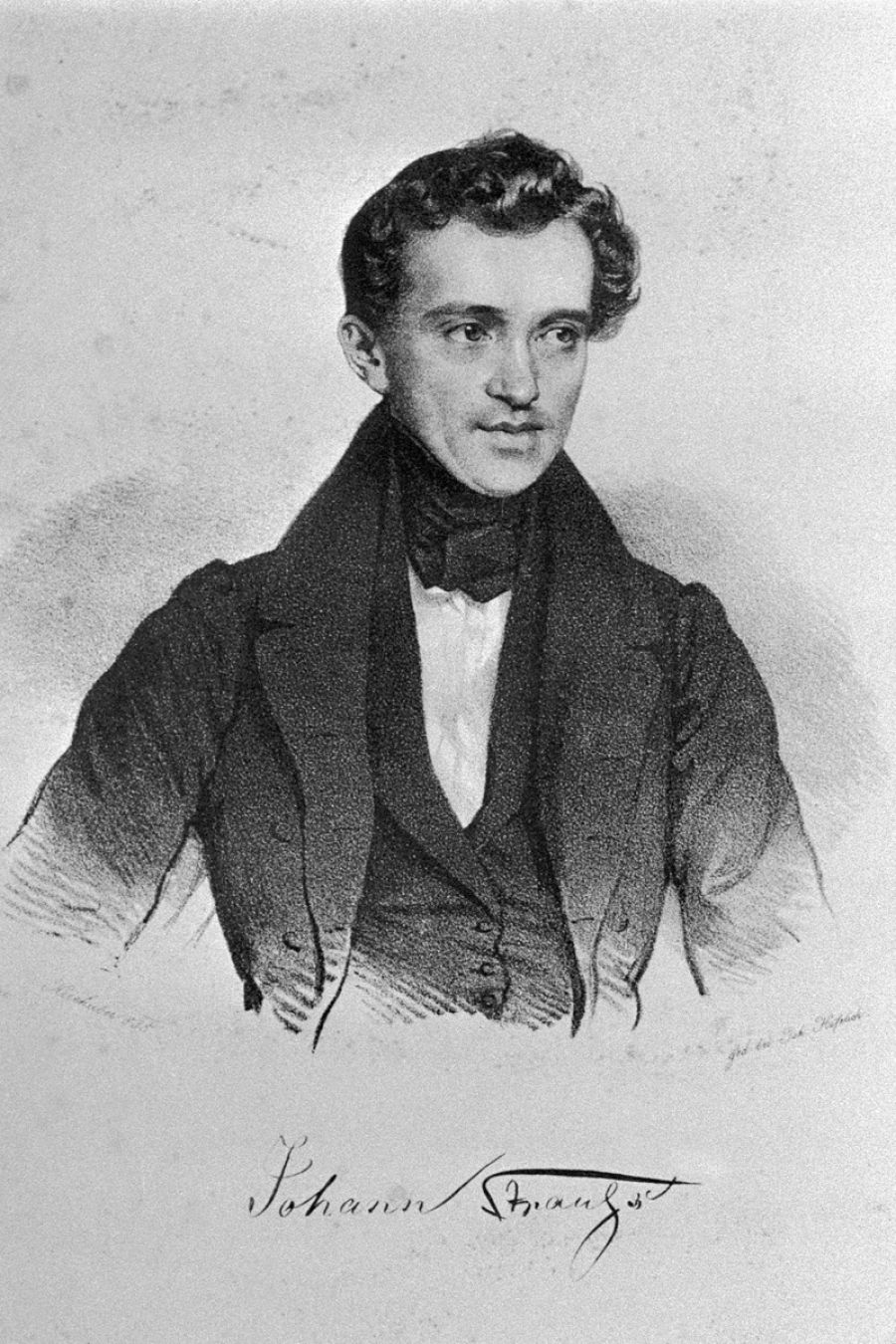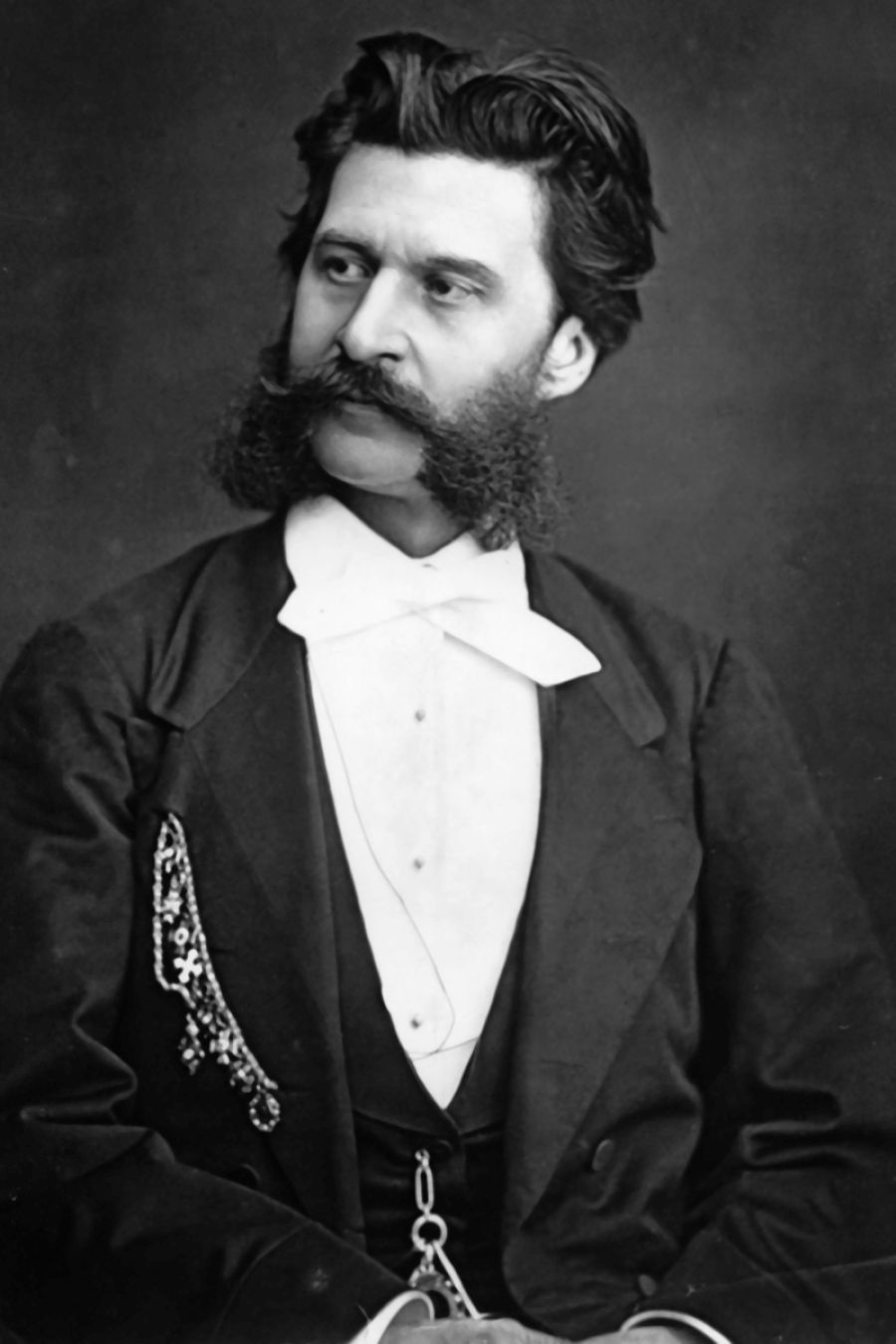Walzerproduktion Strauß und Söhne - Deutsche Oper Berlin
The waltz factory of Strauß & Sons
An essay by Lars Gebhardt
“I have a mind to play with a 12-15-piece orchestra in various establishments, at the Dommayer in Hietzing, for instance, which has already told me we’ll be able to perform there as soon as my orchestra is up and running. I cannot yet say which other places will have us, but I reckon I’ll have enough work and money coming in.” These words formed part of a letter sent on 3rd August 1844 to Vienna City Council by Johann Strauß [son], who had just turned 18 and was applying for permission to set up his own recreational orchestra. This was the first ever petition of its kind and quite surprising considering that his father had been dominating Vienna’s music scene since the 1820s and, as court kapellmeister, had succeeded in elbowing out his rival, Joseph Lanner, in the Austrian capital. Johann Strauß [father] had established his international reputation with a string of European tours and made the Vienna waltz famous the world over. His tours had him and his band playing at Queen Victoria’s coronation festivities in London and on many occasions at the Prussian court. Gushing critics dubbed him the “Mozart of waltzes”, the “Paganini of galops” and the “Rossini of potpourris”. And so it was that Johann Strauß Sr. came to be granted a place at the top table of “learnèd musicians” with his light music and dance accompaniments. In his concerts he was an enthusiastic combiner of waltzes, marches and other dance forms with works by Beethoven, Berlioz and Schumann. In this he was instrumental in the growth of “more serious” music.
The family was in crisis around this time, however. Johann Strauß [father] separated from his wife Anna and in the summer of 1844 went so far as to seek a divorce. Unbeknown to their father, and later against his wishes, Schanni and Pepi - and later Edi, too – had been having music lessons since their youth; it was a logical next step that young Johann would contribute as a breadwinner following the parents’ divorce – preferably with his own band. Schanni’s application was approved – in the face of an energetic appeal to the contrary lodged by his father with the City Council – and it was not long before father and son were at loggerheads, competing for audiences’ favour, looking for new venues and coming up with innovative formats. In his appearances in the city’s gastronomic establishments and at outdoor concerts in parks and squares Johann Strauß Jr. soon drew level with his father in proficiency and came to outdo him in prestige. Schanni’s first concerts drew the following plaudit from the Wiener Tageszeitung: “The audiences’ enthusiasm for the young Strauß is growing by the day. They love his compositions and clap him when he performs them. Which means the 1845 carnival will be spoilt for musical choice and Vienna’s damsels now have the prospect of dancing to the tunes of two Strauß violins.”
1848, the year of revolution, marked a caesura. Schanni’s marches and dances, which he was writing for the more progressive students and the National Guard, began to grate at the court. Works like the “Barrikaden-Lieder op. 52” and the “Brünner Nationalgarde-Marsch op. 58” were banned temporarily and the scores confiscated. In the reactionary atmosphere that followed 1848 the court was wary of the works being turned out by the young Johann, with the emperor turning a deaf ear to even his greatest triumphs. Not until 1863 would Schanni finally land the job of court kapellmeister – over 13 years after the death of his father. On 31st August 1848 Johann the Elder, conservative and royalist, was able to conduct the premiere of his “Radetzky March in honour of the great Field Marshal of the Imperial and Royal Army”. This triumphal march of the conservative camp remains his most popular work. But soon the mood had swung and youthful audiences were increasingly spurning performances by Johann Strauß [father]. Schanni became the voice of youth and progress. The private ructions within the Strauß family and even the music of light entertainment reflected the political and social ruptures associated with the upheavals in the middle years of the 19th century. Father Strauß did not live to see 1848 out, dying on 25th September of brain paralysis and scarlet fever contracted from one of his daughters.

Schanni took over his father’s orchestra – not without resistance – and amalgamated it with his own but failed to secure the right to play the court’s music. His two younger brothers took up composing and both were appointed to kapellmeister posts. Josef especially managed to emerge from the shadow of his brother on a regular basis. In years to come “little Edi” was to prove a skilful organiser and steer the fortunes of the family. A run of successful years followed in which the brothers formed a veritable “Strauß Inc.”.
An exciting trip made by Johann Strauß to Warsaw for the Three Emperors’ meeting in 1850 ended perfectly, with the Russian Emperess Charlotte, daughter of Frederick William III, inviting the young Strauss to a concert - the “Warschauer Polka op. 84” – dedicated to her. Johann’s charm and comportment resulted in a crucial invitation to the court at St Peterburg and a commission as kapellmeister for the summer concerts in the neighbouring town of Pavlovsk. Over the next ten years Johann and, later, Josef spent their summers there, delivering open-air programmes of musical entertainment. Those summers also proved significant for his private life: a romance with Olga Smirnitzki intensified over the summer of 1859, but her family succeeded in blocking a marriage. A flurry of other liaisons – not only in Russia – enhanced the mystique of the brilliant artist / lady’s man. In 1862 he married Henriette von Treffz, his first wife. Seven years his senior, Henriette, a singer, became a driving force behind Johann’s creativity. Like Johann’s mother Anna before her, she networked, took charge of the tour management and helped with the transcription of scores.

Concert tours took Schanni to London and Paris in 1867. His waltzes embellished the World’s Fair in the French capital and at the ‘Prom’ concerts in London his “Blue Danube” waltz, originally written for the Vienna Male Voice Choir, became a global hit. Strauß brought the concept of the promenade concert back with him to Vienna: conversing couples would stroll around the ballroom floor waiting for Strauß to raise his violin bow – the signal that another dance was about to begin. His “Erinnerungen an Covent-Garden” op. 329, which adapted British and American ‘pop songs’ into waltzes, is a testimony to the huge success of the format.
1870 marked another sea change. Within a short space of time Johann lost his mother Anna and brother Josef, his two most important artistic allies. Not long afterwards Eduard took sole charge of the bands in Vienna while Johann withdrew, even asking to be relieved of his duties as head of court ballroom music. He was soon addressing a new challenge, however: the music of staged light-entertainment. The period from the mid-1860s onwards was the heyday of Jacques Offenbach, who was flooding Vienna with operettas, of which LA BELLE HÉLÈNE made a lasting impression on Strauß. Since his focus was increasingly on composing vocal waltzes and works for choruses, it was no great leap to operetta.
But before he penned his third operetta, THE BAT, which was to have a defining impact on the Vienna operetta genre, Strauß set off on an American adventure. Patrick Sarsfield Gilmore, a bandmaster specialising in large-scale concerts featuring detonations, cannon salvoes and a 20,000-strong cast, invited Strauß to appear at the 1872 World’s Peace Jubilee in Boston for the princely fee of 100,000 dollars plus expenses. Between 17th June and 4th July he conducted 14 concerts including one mega concert involving 1,000 musicians and numerous sub-conductors before an audience of 50,000. Strauß was billed as an international star. One poster “depicted him as a king, with the globe as his throne and a sceptre as his baton, alluding to a world in thrall to his music.” After the Boston concerts he was smothered with requests for concerts but instead chose to return to Vienna, where his subsequent operettas heralded a new chapter in the art of the genre. Eduard Strauß continued the tradition of light music and dance waltzes in his capacity as court kapellmeister and on numerous European tours.
Johann Strauß [father] and his three sons Johann [“Schanni”], Josef [“Pepi”] and Eduard [“Edi”] dominated Vienna’s light music scene between the 1820s and 1890s. Despite all their quarrels, differences and personal rifts the Strauß brand came to be synonymous with well written music for dance and light entertainment, with the eldest son in particular managing to reinvent himself time and again in the course of his long career.

